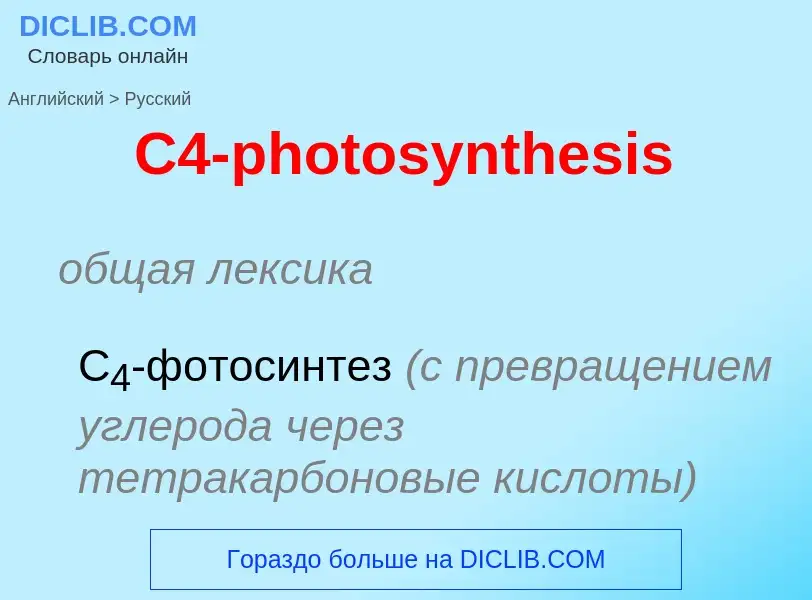Tradução e análise de palavras por inteligência artificial ChatGPT
Nesta página você pode obter uma análise detalhada de uma palavra ou frase, produzida usando a melhor tecnologia de inteligência artificial até o momento:
- como a palavra é usada
- frequência de uso
- é usado com mais frequência na fala oral ou escrita
- opções de tradução de palavras
- exemplos de uso (várias frases com tradução)
- etimologia
C4-photosynthesis - tradução para russo
общая лексика
C4-фотосинтез (с превращением углерода через тетракарбоновые кислоты)
общая лексика
C4-растение (по типу фотосинтеза)
общая лексика
первичный продукт фотосинтеза
Definição
Wikipédia
C4 carbon fixation or the Hatch–Slack pathway is one of three known photosynthetic processes of carbon fixation in plants. It owes the names to the 1960's discovery by Marshall Davidson Hatch and Charles Roger Slack that some plants, when supplied with 14CO2, incorporate the 14C label into four-carbon molecules first.
C4 fixation is an addition to the ancestral and more common C3 carbon fixation. The main carboxylating enzyme in C3 photosynthesis is called RuBisCO, which catalyses two distinct reactions using either CO2 (carboxylation) or oxygen (oxygenation) as a substrate. The latter process, oxygenation, gives rise to the wasteful process of photorespiration. C4 photosynthesis reduces photorespiration by concentrating CO2 around RuBisCO. To ensure that RuBisCO works in an environment where there is a lot of carbon dioxide and very little oxygen, C4 leaves generally differentiate two partially isolated compartments called mesophyll cells and bundle-sheath cells. CO2 is initially fixed in the mesophyll cells by the enzyme PEP carboxylase which reacts the three carbon phosphoenolpyruvate (PEP) with CO2 to form the four carbon oxaloacetic acid (OAA). OAA can be chemically reduced to malate or transaminated to aspartate. These intermediates diffuse to the bundle sheath cells, where they are decarboxylated, creating a CO2-rich environment around RuBisCO and thereby suppressing photorespiration. The resulting pyruvate (PYR), together with about half of the phosphoglycerate (PGA) produced by RuBisCO, diffuses back to the mesophyll. PGA is then chemically reduced and diffuses back to the bundle sheath to complete the reductive pentose phosphate cycle (RPP). This exchange of metabolites is essential for C4 photosynthesis to work.
On one hand, these additional steps require more energy in the form of ATP to regenerate PEP. On the other hand, concentrating CO2 allows high rates of photosynthesis at higher temperatures. Higher concentration overcomes the reduction of gas solubility with temperature (Henry's law). The CO2 concentrating mechanism also maintains high gradients of CO2 concentration across the stomatal pores. This means that C4 plants have generally lower stomatal conductance, reduced water losses and have generally higher water-use efficiency. C4 plants are also more efficient in using nitrogen, since PEP carboxylase is much cheaper to make than RuBisCO. However, since the C3 pathway does not require extra energy for the regeneration of PEP, it is more efficient in conditions where photorespiration is limited, typically at low temperatures and in the shade.

![Cross section of a [[maize]] leaf, a {{C4}} plant. Kranz anatomy (rings of cells) shown Cross section of a [[maize]] leaf, a {{C4}} plant. Kranz anatomy (rings of cells) shown](https://commons.wikimedia.org/wiki/Special:FilePath/Cross section of maize, a C4 plant..jpg?width=200)
![Portrait of [[Jan Baptist van Helmont]] by [[Mary Beale]], c. 1674 Portrait of [[Jan Baptist van Helmont]] by [[Mary Beale]], c. 1674](https://commons.wikimedia.org/wiki/Special:FilePath/Jan Baptist van Helmont portrait.jpg?width=200)
![The [[leaf]] is the primary site of photosynthesis in plants. The [[leaf]] is the primary site of photosynthesis in plants.](https://commons.wikimedia.org/wiki/Special:FilePath/Leaf 1 web.jpg?width=200)
![[[Melvin Calvin]] works in his photosynthesis laboratory. [[Melvin Calvin]] works in his photosynthesis laboratory.](https://commons.wikimedia.org/wiki/Special:FilePath/Melvin Calvin.jpg?width=200)
![Plant cells with visible chloroplasts (from a moss, ''[[Plagiomnium affine]]'') Plant cells with visible chloroplasts (from a moss, ''[[Plagiomnium affine]]'')](https://commons.wikimedia.org/wiki/Special:FilePath/Plagiomnium affine laminazellen.jpeg?width=200)
![Composite image showing the global distribution of photosynthesis, including both oceanic [[phytoplankton]] and terrestrial [[vegetation]]. Dark red and blue-green indicate regions of high photosynthetic activity in the ocean and on land, respectively. Composite image showing the global distribution of photosynthesis, including both oceanic [[phytoplankton]] and terrestrial [[vegetation]]. Dark red and blue-green indicate regions of high photosynthetic activity in the ocean and on land, respectively.](https://commons.wikimedia.org/wiki/Special:FilePath/Seawifs global biosphere.jpg?width=200)

